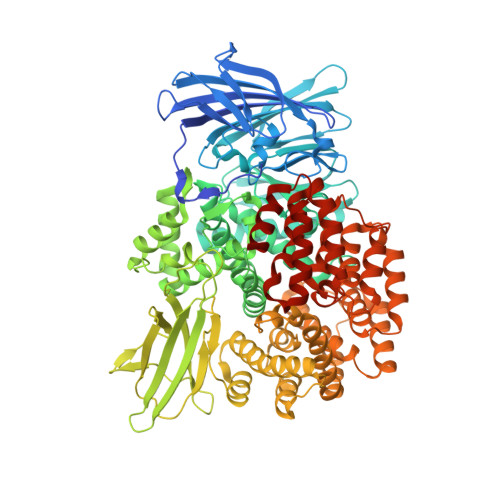Insight into the remarkable affinity and selectivity of the aminobenzosuberone scaffold for the M1 aminopeptidases family based on structure analysis.
Peng, G., McEwen, A.G., Olieric, V., Schmitt, C., Albrecht, S., Cavarelli, J., Tarnus, C.(2017) Proteins 85: 1413-1421
- PubMed: 28383176
- DOI: https://doi.org/10.1002/prot.25301
- Primary Citation of Related Structures:
5MFR, 5MFS, 5MFT - PubMed Abstract:
Aminopeptidases are ubiquitous hydrolases that cleave the N-terminal residues of proteins and oligopeptides. They are broadly distributed throughout all kingdoms of life and have been implicated in a wide variety of physiological processes, including viral infection, parasite metabolism, protein processing, regulation of peptide hormones, and cancer cell proliferation. Members of the M1 family, also termed gluzincins, are defined by two highly conserved motifs in the catalytic domain: a zinc-binding motif, HEXXH-(X18)-E; and an exopeptidase motif, GXMEN. We report the high-resolution X-ray structures of E. coli aminopeptidase N (PepN) in complex with three aminobenzosuberone scaffolds that display various Ki values (50, 0.33, and 0.034 µM) and provide a compelling view of the outstanding selectivity of these chemical entities for the M1 aminopeptidases. This series of inhibitors interacts as transition state mimics with highly conserved residues of the catalytic machinery and substrate recognition sites. Structural comparisons and model-building studies allowed a deep interpretation of the SAR observed for bacterial, as well as mammalian enzymes. Proteins 2017; 85:1413-1421. © 2017 Wiley Periodicals, Inc.
Organizational Affiliation:
Paul Scherrer Institut (SLS) WSLB, 5232, Villigen, Suisse, Switzerland.





















